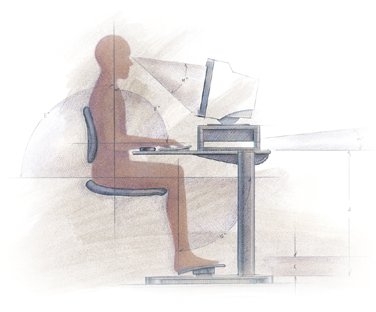Motivations for the Studies of HCI
From Computing and Software Wiki
(→Principles of Ergonomics:) |
(→Principles of Ergonomics:) |
||
| Line 96: | Line 96: | ||
4. ''Work at Proper Heights'': Working at the right height is also a way to make things easier. | 4. ''Work at Proper Heights'': Working at the right height is also a way to make things easier. | ||
| - | |||
5. ''Reduce Excessive Motions'': The next principle to think about is the number of motions you make throughout a day, whether with your fingers, your wrists, your arms, or your back. | 5. ''Reduce Excessive Motions'': The next principle to think about is the number of motions you make throughout a day, whether with your fingers, your wrists, your arms, or your back. | ||
Revision as of 07:25, 23 November 2009
Contents |
Overview
As the capabilities of available technologies continue to grow, the technology itself becomes available to more types of user, each with different demands, goals, and needs. A good Human-Computer Interface (HCI) needs to address the limitations and needs of its user. In addition to meeting the needs of a growing and diverse user-base, research needs to be done in the field of HCI for computers to be accessible in mobile environments, to act as cost-saving measures, to ensure quality software development, and to address the health and safety of the user. These and other motivations elaborated below allow for engineers understand the subjective needs of the user.
Motivations
Integration into Human Lifestyles
- Users are not tolerant of poorly designed interfaces. Often users are susceptible to frustration, will not invest time in learning an unintuitive interface and will seek out a more suitable product or solution.
- Consumers require products that are easy to learn and intuitive to navigate, especially as they are integrated into their daily lives. The best example of this is the innovation of the World Wide Web, which is considered to be the direct result of HCI research.[1] Especially in the mid 1990’s when the personal computer was not commonplace in the average North American home the way it is today, the idea of navigating over the web would be insurmountable to new users. HCI research, particularly related to direct manipulation led to the use of hyperlinks, making use of the internet accessible for new users.
- The ways in which users adopt technology into their daily lives requires businesses to come up with interaction styles fitting to the context in which the technology is being used. Jobs require users to have access to computing resources away from their static desktop computer. For this reason, PDA’s, smart phones, and pocket PC’s have recently become commonplace in the business environment. New studies in HCI are required to make mobile interaction realistic so that the user is able to work just as effectively in a mobile environment. [2]
- Training is expensive. Users should not have the responsibility of allocating time, money, and motivation to learning a new interaction style. A good interface as the result of HCI studies would not place this burden on the user.
Business/Commerical Motivations
- Study of Technology Insertion Techniques in HCI can be used to reduce errors. Ultimately, this means a company can avoid errors that result in the loss of time, money, morale, and other costly factors.
- The costs of training, motivating, and maintaining humans far outweigh the costs of developing hardware and software interaction systems. Effective HCIs allow workers to overcome human limitations and work more productively.
- Businesses can use HCI research as motivations for developing new business models. For example, in 2009 Microsoft announced plans for Natal, a peripheral for the Xbox 360 home gaming console that uses physical movement and gesture recognition to make the gaming controller obsolete. Furthermore, the business decision is that consumers would be able to get a cutting-edge interaction experience without having to spend upwards of $500 on a new console. By studying HCI and applying new interaction techniques, Microsoft stands to change the gaming business model in a way that reduces their marketing costs and satisfies customers. [3]
Accessibility Concerns
- Research in HCI must be done as a precautionary measure. A user may suffer from epilepsy or other complications arising from photosensitivity that can lead to convulsions, disorientation, and other harmful affects. Studies of refresh rates, jarring contrasts, allowable changes in brightness, and human vision concerns are necessary to avoid potentially harming the user.
- The burden of communication is on the GUI. The application must be able to effectively communicate what actions are available to avoid misuse. This involves the study of regional languages, vision loss in the elderly, colourblindness, and how to accommodate other accessibility issues. Not only do these concepts need to be researched, but HCI's need to be studied to understand how to effectively integrate those accessability concerns into the system without introducing more confusion that could disrupt the system or harm the user.
- A GUI is only as effective as the actions it is capable of performing. Studies of behavioural patterns, learning rates, and visual stimuli are needed to determine how users become more comfortable with the interface. By making an interface available to a variety of users with different levels of aptitude (novice, intermediate, expert) the interface becomes more useful in fulfilling its purpose. [4]
Quality Assurance of Software
Development of Industry Standards
Human Factors
Human Factors is an umbrella term for several areas of research. Motivation rises for the study of human factors that include human performance, technology design and Human-Computer Interaction (HCI). Human factors is often used interchangeably with User Interface Design or Human-Computer Interaction.
The concept of human factors emerged during the industrial revolution and became a full-fledged discipline during World War II.
Human factors recognized that aircraft cockpit design needed to consider the human interface for controls and displays.Design engineers focused on technology and the industrial psychologists worked to optimize the interface. There is a tremendous overlap in these disciplines. Human factors refer to hardware design and HCI is frequently used by the software engineers. Engineering psychologists work in both disciplines and the overlap is considered greater than the difference. http://www.duke.edu/web/informatics/HF/HumanFactors.html
Another example of this area of research occurs in the Human Factors Research and Technology Division at NASA Ames Research Center [4]. This area focuses on the need for safe, efficient and cost-effective operations, maintenance and training, both in flight aircrafts and on the ground.
See below for further information on some specific subjects of human factors.
Human Performance
Human factors and HCI integrates the use of human mental abilities, such as short/long-term memory, visual scanning and hearing. HCI not only includes the specification, design, and development of systems, but also the actual training, skill levels and organizational aspects of the end users. Therefore, motivation for the understanding of information technology and HCI becomes stronger and easier. HCI also includes several areas that are similar to the interaction of humans and machines. These areas include staffing, personnel, training, human factors engineering, and health risks.
Other things such as managerial, public, and personal safety issues dealing with computers also plays a big role in the development of an effective HCI. Issues that should be with an HCI are the designs of language, data-entry techniques, graphics, visual representation, and consistency; see Five Interaction Styles. Therefore, motivation for the studying of HCI through the research of human factors is a comprehensive expression covering an assortment of areas that involve the use of an effective HCI, from the computer components with the healthcare system to the Supervisory Control And Data Acquisition (SCADA) software used within major safety critical systems, such as a nuclear power plant.
Technology Design
| 1.) 128-bit SSL Security |
| 2.) Software Pin Pads |
| 3.) Two-factor Authentication |
| 4.) Timeouts |
| 5.) Reference Numbers |
| 6.) Masked Account Numbers |
Human-Computer Interaction
Ergonomics
Definition:
The term Ergonomics is derived from two Greek words Nomoi meaning natural laws and Ergon meaning work. Hence, ergonomists study human capabilities in relationship to work demands.
Principles of Ergonomics:
There are 10 basic principles:
1. Work in Neutral Postures: Your posture provides a good starting point for evaluating the tasks that you do. The best positions in which to work are those that keep the body "in neutral."
2. Reduce Excessive Force: Excessive force on your joints can create a potential for fatigue and injury. In practical terms, the action item is for you to identify specific instances of excessive force and think of ways to make improvements.
3. Keep Everything in Easy Reach: The next principle deals with keeping things within easy reach. In many ways, this principle is redundant with posture, but it helps to evaluate a task from this specific perspective.
4. Work at Proper Heights: Working at the right height is also a way to make things easier.
5. Reduce Excessive Motions: The next principle to think about is the number of motions you make throughout a day, whether with your fingers, your wrists, your arms, or your back.
6. Minimize Fatigue and Static Load: Holding the same position for a period of time is known as static load. It creates fatigue and discomfort and can interfere with work.
7. Minimize Pressure Points: Another thing to watch out for is excessive pressure points, sometimes called "contact stress."
8. Provide Clearance: Having enough clearance is a concept that is easy to relate to.
9. Move, Exercise, and Stretch: To be healthy the human body needs to be exercised and stretched.
10. Maintain a Comfortable Environment: This principle is more or less a catch-all that can mean different things depending upon the nature of the types of operations that you do.
this is Fitts's law
See Also
http://www.duke.edu/web/informatics/HF/HF-ergonomics.html
References
- 1. A brief history of human-computer interaction technology. ACM Interactions. http://portal.acm.org/citation.cfm?doid=274430.274436
- 2. Using while moving: HCI issues in fieldwork environments. ACM Transactions on Computer-Human Interaction (TOCHI) http://delivery.acm.org/10.1145/360000/355329/p417-pascoe.pdf?key1=355329&key2=2746298521&coll=GUIDE&dl=GUIDE&CFID=64390082&CFTOKEN=12638977
- 3. Reuters: Microsoft unveils new Xbox technology, enlists Facebook. http://www.reuters.com/article/internetNews/idUSTRE5506FO20090601
- 4. Poelman, S. (2009) Software Engineering 4D03/6D03/Computer Science 4HC3 Lecture Notes
- 5. Human Factors 101. http://human-factors.arc.nasa.gov/web/hf101/
- 6. Fitts's Law: [1]
--Katmehm 02:05, 23 November 2009 (EST) </div>



